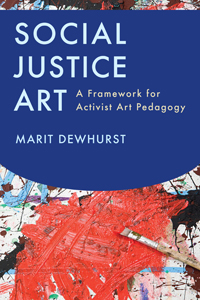 BACK OF THE BOOK
BACK OF THE BOOK
Based on interviews and observations of sixteen high schoolers participating in an activist arts class at a New York City museum, Dewhurst identifies three learning processes common to the act of creating art that have an impact on social justice: connecting, questioning, and translating. Noting that “one of the challenges of social justice art education has been the difficulty of naming effective strategies that can be used across multiple contexts,” Dewhurst outlines core strategies for an “activist arts pedagogy” and offers concrete suggestions for educators seeking to incorporate activist art projects inside or outside formal school settings. Social Justice Art seeks to give common language to educators and others who are looking to expand and refine their practices in an emerging field, whether they work in art education, social justice programming, or youth development. You can buy the book via Harvard Education Press, Amazon, or your local bookstore. Here’s a discount code.
RELATED RESOURCES
Interview on Harvard EdCast
Related essay featured in Harvard Education Letter
RELATED EVENTS
Teaching for Justice: Engaging Youth in Social Change, a discussion about similarities between Social Justice Art and Dr. Shira Epstein’s new book, Teaching Civic Literacy.
Arterveners Conference on Social Justice Art: I’ll be a guest speaker at this special one-day conference focused on how art is used in community change.

